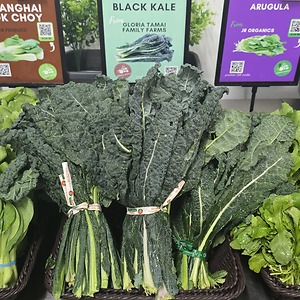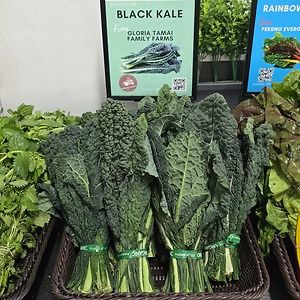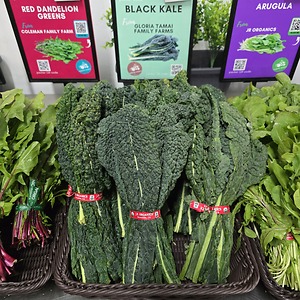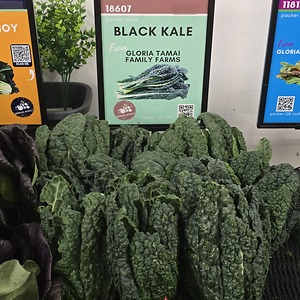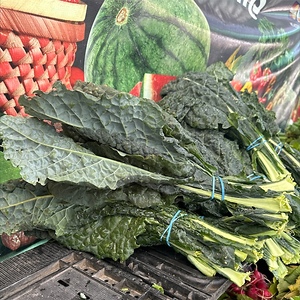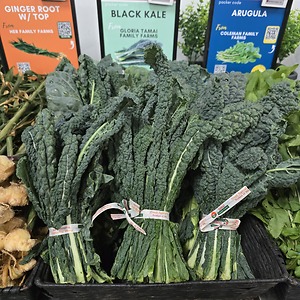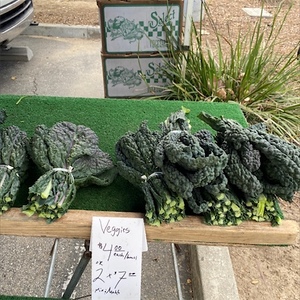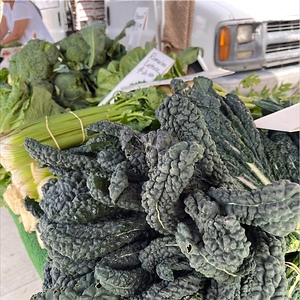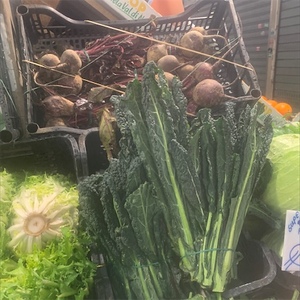

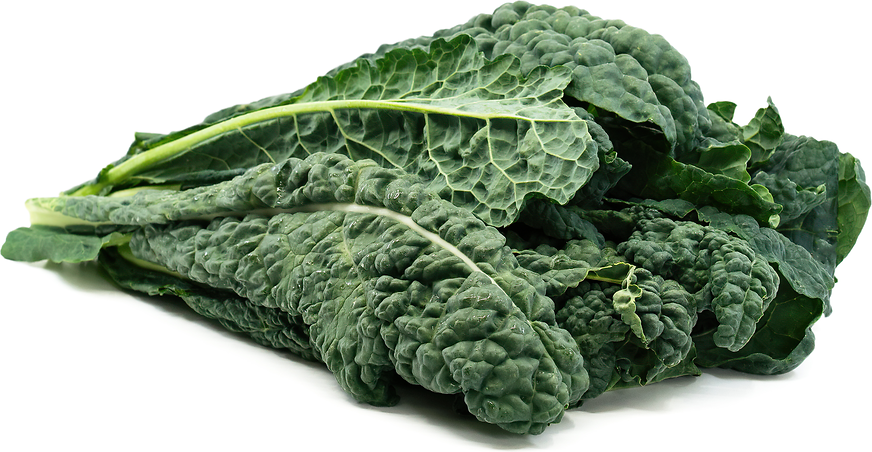
Black Kale
Estimated Inventory, bunch : 0
Description/Taste
Black kale is a long, slender leafy vegetable, typically measuring between 26 and 46 centimeters in length. Its leaves grow from a sturdy central stalk, which is thin at the top and gradually thickens toward the base. Conversely, the leaves are widest at the top and narrow down toward the stem's base. Black kale leaves are crinkly and deeply veined, showcasing a rich green hue with subtle hints of blue or black. Their pebbled texture is accented by curled edges. These leaves are sturdy, thick, and firm, with a soft, almost waxy feel. Black kale has a chewy texture that softens easily when cooked, offering a subtle green cabbage flavor with a tangy bite. It has a slight bitterness and nuttiness, complemented by a sweet, earthy finish.
Seasons/Availability
Black kale is available year-round with a peak season from late fall to spring.
Current Facts
Black kale is botanically classified as Brassica oleracea and belongs to the Brassicaceae family, which also includes collard greens, broccoli, cabbage, and Brussels sprouts. This variety is commonly referred to as Lacinato kale, Tuscan kale, Italian Black cabbage, or Cavalo Nero. It’s also called Dinosaur kale because its heavily crinkled texture looks like the skin of a dinosaur. Black kale is one of four main types of kale within the species, alongside Scotch, Siberian, and Collard kale. It is an Italian heirloom that has been used in Tuscan cooking for centuries. In addition to its culinary offerings, Black kale can serve as an ornamental plant in gardens as its curled leaves resemble a decorative rosette pattern. The plants grow to about half a meter to one meter tall and can be cultivated in containers, pots, and raised beds.
Nutritional Value
Black kale is a significant source of vitamins A, C, and K, which play key roles in maintaining healthy skin, boosting the immune system, and supporting bone health. The high levels of calcium in Black kale contribute to strong bones and teeth, while its iron content helps improve oxygen circulation and prevents anemia. This vegetable is rich in potassium, which supports heart health and regulates blood pressure. It also provides a fair amount of beta-carotene, an antioxidant that protects against cell damage and promotes healthy vision. Black kale is packed with fiber, aiding in digestion and promoting satiety after eating.
Applications
Black kale can be enjoyed raw, roasted, sautéed, braised, juiced, steamed, or air-fried. It's especially tender when young and often used as a salad green. The fully mature leaves are best when cooked, but require minimal cooking when compared to other kale varieties as the central rib is not as as fibrous. Black kale is often tossed with olive oil and salt before being fried into crispy chips. It's also ideal for hardy soups with smoked meats, potatoes, beans, and barley. Black kale pairs well with ingredients like garlic, shallots, onion, bay leaf, oregano, thyme, red pepper flakes, nutmeg, soy sauce, tomatoes, sweet potatoes, peppers, squash, and apples. It complements proteins such as roasted meats, chicken, pancetta, and chorizo sausage. Black kale should be sealed in a plastic bag in the refrigerator where it will last up to a week.
Ethnic/Cultural Info
Thomas Jefferson is credited as one of the biggest influencers in popularizing kale in the United States. He grew this vegetable in his garden at Monticello, a historic house in Colonial Williamsburg, Virginia, where the former president signed the Declaration of Independence. The gardens at Monticello featured a diverse array of ornamental and edible plants from around the world, many of them vegetables. He received kale seeds from French Botanist André Thüin in 1811 and continued planting them for years. Jefferson viewed kale as the finest winter vegetable in the garden, particularly enjoying its sweet, tender texture as well as its durability throughout the winter months. He planted many different varieties including Russian, Buda, Delaware, Scotch, and Black kale, becoming an expert in the vegetable by the end of his life.
Geography/History
Black kale is an heirloom variety native to the Tuscany region of Central Italy. This variety tolerates full sun but thrives best when grown in partial shade in fertile, well-drained soils. As a domesticated vegetable, Black kale has been developed through human cultivation and is primarily grown commercially and in home gardens. This variety originated in 18th-century Italy. European explorers are believed to have brought Black kale seeds with them on their journeys to North America. In the United States, kale gained popularity alongside the growing trend of superfoods and farm-to-table dining. Its acclaim soared in the 2010s, thanks in large part to American marketer Oberon Sinclair, who turned her passion for kale into a nationwide sensation. She promoted the vegetable by writing about it on chalkboards throughout New York City. This effort caught the attention of renowned chefs and celebrities, helping to elevate kale's status in culinary circles. Among the most popular varieties to emerge during this time was Black kale. Today, this variety can be grown from seed in gardens or sourced from high-end grocers, specialty vegetable stores, and farmers' markets across the United States, Canada, China, and Italy.
Recipe Ideas
Recipes that include Black Kale. One
Podcast







